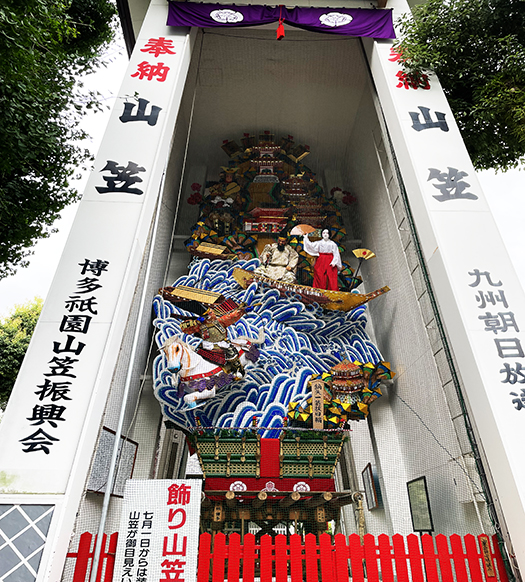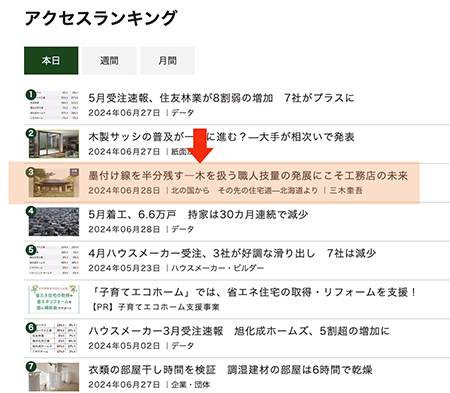編集部に記事を送付してから他の案件や旅行に突入していたので、ご案内が1日遅れましたが、わたしの連載記事:新建ハウジングdigital連載「その先の住宅道」のvol5が掲載されました。
https://www.s-housing.jp/archives/354151
今月は北海道の「高断熱高気密」住宅革新運動の最初期からの中枢メンバーであり、同時に在来木造工法の技術伝統を「北の民家の会」などの活動を通じて訴求し続けている武部建設さんのポリシーを中心にした記事構成としています。
「墨付け線の半分を残す」という大工技量の発展、その技術こそが次の時代を切り開いていくキーポイントになり、同時にそうした大工人材育成こそが最重要という視点で書いた次第。北海道の住宅建築は最初期から寒冷への対応、克服が最大のテーマであり続け、工法については日本社会の伝統であった軸組構造をどう革新していくか、だったのだけれど、そこからさらに離陸していくには、その原点へのさらなるこだわりが不可欠だと思えるのです。ぜひ記事をご覧いただければ幸いです。

・・・というところですが、いま現在はわたしは北部九州・福岡県を旅行中。福岡・博多と言えばやはり山笠であります。博多の町衆の心意気が爆発する、血湧き肉躍る祭事。きのうはその中核のような「櫛田神社」に早朝参詣。
福岡は札幌よりも人口は少ないのですが、歴史的にも大陸・半島との交流の最大の「玄関口」として機能してきて、経済活動としては、日本全体の中でも最先端地域であり続けた。今日に残り続けている山笠は、そういう言ってみれば「民衆経済」の歴史を背負っていて、素晴らしい。北海道札幌は、明治以来の国家による官主導型の社会構造と、民の活もその枠内でのものに留まっている側面がある。
開拓以来150年を超えてきて、民衆型の経済構造が獲得できていくのかどうかという局面。
そういう意味では「住宅産業」は、ポテンシャルとしてはあり得るのかも知れない。高断熱高気密という日本の歴史の中でも最先端の技術領域を生み出してきた。今後の北海道人は、こういう博多の民衆の心意気を学んで行くべきではないか。
そんなことどもも含めて、今回の北部九州の旅は面白い気付きにたくさん出会えている。
English version⬇
[Published in Shinken Housing Digital Serialization “The Housing Road Ahead” vol.5
Cold regions have reached a unique technological revolution from the innovation of traditional construction methods. Today, we should re-focus on the core power of carpentry technology. …
I have been traveling and working on other projects since I sent the article to the editorial office, so I am a day late, but vol. 5 of my series of articles in Shinken Housing Digital, “The Housing Road Ahead,” has been published.
https://www.s-housing.jp/archives/354151
This month’s article focuses on the policies of Takebe Kensetsu, a core member of Hokkaido’s “highly insulated and airtight” housing innovation movement since its inception, and a company that continues to promote the technical traditions of conventional wood construction through activities such as the “Kita no Minka no Kai.
The article was written from the viewpoint that the development of carpentry skills, such as “leaving half of the marked lines,” is the key to paving the way for the next generation, and at the same time, the training of such carpenters is of utmost importance. From the beginning, the biggest theme of residential construction in Hokkaido has been to cope with and overcome the cold weather, and to innovate the traditional Japanese axial structure in terms of construction methods. We hope you will take a look at the article.
I am currently traveling in Fukuoka Prefecture in northern Kyushu. The most famous festival in Hakata, Fukuoka, is Yamakasa, or Yamakasa Festival. The spirit of the Hakata townspeople explodes in this bloodcurdling festival. Yesterday morning, I paid an early morning visit to Kushida Shrine, which is the core of the festival.
Although Fukuoka has a smaller population than Sapporo, it has historically served as the largest “gateway” for exchange with the continent and peninsula, and has remained one of the most advanced regions in Japan as a whole in terms of economic activity. Yamakasa, which continues to remain today, bears the history of such “people’s economy,” so to speak, and it is wonderful. In Sapporo, Hokkaido, the social structure has been led by the government since the Meiji era, and the activities of the people have remained within the framework of this structure.
After more than 150 years of pioneering, the question is whether or not a people-oriented economic structure will be achieved.
In this sense, the “housing industry” may have potential. It has produced one of the most advanced technological fields in Japan’s history: high thermal insulation and airtightness. I believe that the people of Hokkaido should learn from the spirit of the people of Hakata.
In this and other ways, my trip to northern Kyushu this time has brought me many interesting insights.
Posted on 6月 30th, 2024 by 三木 奎吾
Filed under: 住宅マーケティング









コメントを投稿
「※誹謗中傷や、悪意のある書き込み、営利目的などのコメントを防ぐために、投稿された全てのコメントは一時的に保留されますのでご了承ください。」
You must be logged in to post a comment.